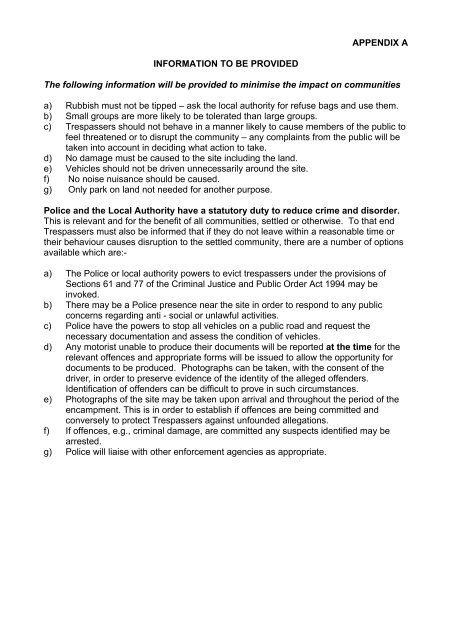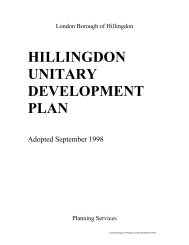Protocol for Dealing with Unauthorised Encampments - London ...
Protocol for Dealing with Unauthorised Encampments - London ...
Protocol for Dealing with Unauthorised Encampments - London ...
Create successful ePaper yourself
Turn your PDF publications into a flip-book with our unique Google optimized e-Paper software.
APPENDIX A<br />
INFORMATION TO BE PROVIDED<br />
The following in<strong>for</strong>mation will be provided to minimise the impact on communities<br />
a) Rubbish must not be tipped – ask the local authority <strong>for</strong> refuse bags and use them.<br />
b) Small groups are more likely to be tolerated than large groups.<br />
c) Trespassers should not behave in a manner likely to cause members of the public to<br />
feel threatened or to disrupt the community – any complaints from the public will be<br />
taken into account in deciding what action to take.<br />
d) No damage must be caused to the site including the land.<br />
e) Vehicles should not be driven unnecessarily around the site.<br />
f) No noise nuisance should be caused.<br />
g) Only park on land not needed <strong>for</strong> another purpose.<br />
Police and the Local Authority have a statutory duty to reduce crime and disorder.<br />
This is relevant and <strong>for</strong> the benefit of all communities, settled or otherwise. To that end<br />
Trespassers must also be in<strong>for</strong>med that if they do not leave <strong>with</strong>in a reasonable time or<br />
their behaviour causes disruption to the settled community, there are a number of options<br />
available which are:-<br />
a) The Police or local authority powers to evict trespassers under the provisions of<br />
Sections 61 and 77 of the Criminal Justice and Public Order Act 1994 may be<br />
invoked.<br />
b) There may be a Police presence near the site in order to respond to any public<br />
concerns regarding anti - social or unlawful activities.<br />
c) Police have the powers to stop all vehicles on a public road and request the<br />
necessary documentation and assess the condition of vehicles.<br />
d) Any motorist unable to produce their documents will be reported at the time <strong>for</strong> the<br />
relevant offences and appropriate <strong>for</strong>ms will be issued to allow the opportunity <strong>for</strong><br />
documents to be produced. Photographs can be taken, <strong>with</strong> the consent of the<br />
driver, in order to preserve evidence of the identity of the alleged offenders.<br />
Identification of offenders can be difficult to prove in such circumstances.<br />
e) Photographs of the site may be taken upon arrival and throughout the period of the<br />
encampment. This is in order to establish if offences are being committed and<br />
conversely to protect Trespassers against unfounded allegations.<br />
f) If offences, e.g., criminal damage, are committed any suspects identified may be<br />
arrested.<br />
g) Police will liaise <strong>with</strong> other en<strong>for</strong>cement agencies as appropriate.
















